

Added 5 May 2007
Monday, 19 March 2007, Bahía Tortugas, Baja California Sur, Mexico to Misión San Borja, Baja California Norte, Mexico
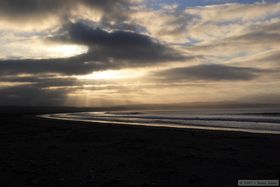
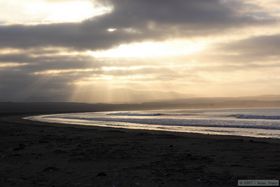 Having not made it to our intended destination for the day before, our plan for the day was a loose one. The plan was to drive out to Malarrimo and check it out in the morning, and either stay there for the night, or start heading east to the Sea of Cortez. I had hoped to get a fairly early start, as we would need a full day to get very far east if we decided not to stay at Malarrimo for the night. Unfortunately, we didn't get packed up as quickly as I'd hoped. Then, just as we were almost all packed up and ready to go, Marisa asked if we would mind if she went beach combing a little bit. Chuck and I paused briefly, but figured 15 minutes or so wouldn't kill us, so we said OK.
Having not made it to our intended destination for the day before, our plan for the day was a loose one. The plan was to drive out to Malarrimo and check it out in the morning, and either stay there for the night, or start heading east to the Sea of Cortez. I had hoped to get a fairly early start, as we would need a full day to get very far east if we decided not to stay at Malarrimo for the night. Unfortunately, we didn't get packed up as quickly as I'd hoped. Then, just as we were almost all packed up and ready to go, Marisa asked if we would mind if she went beach combing a little bit. Chuck and I paused briefly, but figured 15 minutes or so wouldn't kill us, so we said OK.
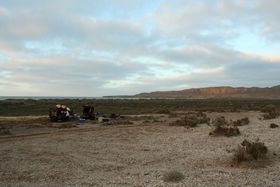
|
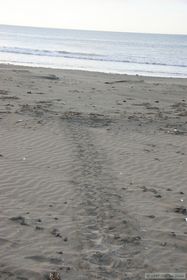
|
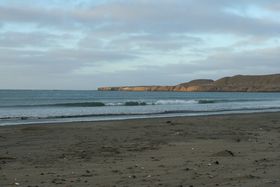
|
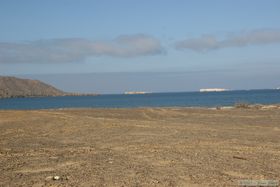
|
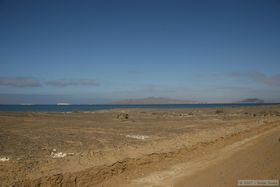
|
While she was gone, Chuck and I had a nice conversation, but by the time Marisa got back we were really ready to hit the road. Marisa was riding with me again, and as we reached the north side of the peninsula heading out to Malarrimo, she had me stop the truck because she suddenly didn't feel well. I called Chuck on the radio to get him to stop, and he came back to where we were while Marisa wandered off because she felt like she was going to throw up.
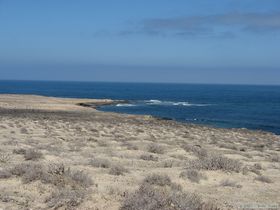 She returned about 15 minutes later, having not thrown up. Chuck and I, after expressing all due concern and sympathy, teased her for walking 1/4 mile away to go and not throw up. She still felt like she was going to throw up though, so she got some water and walked another 1/4 mile to try to throw up again. She returned without throwing up again. We stood around and talked for a while, and when it seemed like she was getting no better nor worse, we got back in the trucks and headed down the road along the shore.
She returned about 15 minutes later, having not thrown up. Chuck and I, after expressing all due concern and sympathy, teased her for walking 1/4 mile away to go and not throw up. She still felt like she was going to throw up though, so she got some water and walked another 1/4 mile to try to throw up again. She returned without throwing up again. We stood around and talked for a while, and when it seemed like she was getting no better nor worse, we got back in the trucks and headed down the road along the shore.
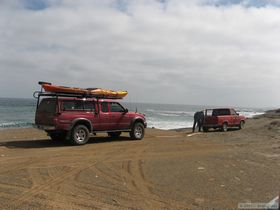 As we headed out to Malarrimo, a local man waved Chuck down and we both pulled in to see what was wrong. The man had buried his two-wheel drive Ford Ranger in some soft ground and needed help getting unstuck. He had been trying to dig himself out so had large mounds of sand piled up around his truck. He showed us what he had been digging with, and it was a steel rod with a flat, shovel shaped piece of plywood bolted to it. Necessity is the mother of invention, I suppose. In retrospect, I wish I had given him my shovel to keep, since Chuck had a shovel if we ended up needing one.
As we headed out to Malarrimo, a local man waved Chuck down and we both pulled in to see what was wrong. The man had buried his two-wheel drive Ford Ranger in some soft ground and needed help getting unstuck. He had been trying to dig himself out so had large mounds of sand piled up around his truck. He showed us what he had been digging with, and it was a steel rod with a flat, shovel shaped piece of plywood bolted to it. Necessity is the mother of invention, I suppose. In retrospect, I wish I had given him my shovel to keep, since Chuck had a shovel if we ended up needing one.
It was easy work for Chuck to pull the man out, earning immense gratitude. He told us that his name was Gilberto, and that if we needed anything while we were in the area, to tell people that we knew him. We had passed his camp getting there, and he also invited us to his camp for a cup of coffee when we headed back out. He was a really nice guy.
After parting, he took off like a bat out of hell towards the direction from which we had come. I can't imagine what he might have been late for. We continued at a moderate pace westward towards Malarrimo, looking forward to what we might find there. Malarrimo is a large J beach that apparently collects flotsam from all over the world, which I gather is it's primary attraction. It is also extremely remote, so not many people go there. After driving a while, Chuck pulled over for a map check. 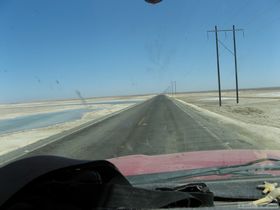 Looking at the maps, he realized that we had a long drive ahead of us. Seeing as how much of the morning was already behind us due to the delays we'd experienced, it was decision time. If we continued forward to Malarrimo, we would have to camp there, and it would mean a very long day of driving the following day to even get anywhere near Misión San Borja, let alone Bahía de los Angeles and the Sea of Cortez.
Looking at the maps, he realized that we had a long drive ahead of us. Seeing as how much of the morning was already behind us due to the delays we'd experienced, it was decision time. If we continued forward to Malarrimo, we would have to camp there, and it would mean a very long day of driving the following day to even get anywhere near Misión San Borja, let alone Bahía de los Angeles and the Sea of Cortez.
We decided to abandon Malarrimo and start heading to San Borja. Since we would be putting in a lot of highway miles, Marisa decided to switch over to ride with Chuck for the rest of the day. On the way back to the main road, we passed Gilberto's camp, and he gave us a hearty wave as we passed. I hope he didn't feel upset about us not stopping in for that cup of coffee.
A big down-side to leaving the area early, was that we had to drive that horrifically rough road back to the main peninsula twice in as many days. I wasn't looking forward to that bone rattling again. Back on the main road, we had a bit of pavement before it went back to dirt. Once on the rough dirt road, Chuck was driving at a moderate pace, so I decided to go ahead of him in hopes of being able to get far enough ahead of him by the time the road went back to pavement that I could take the paved road a little slower and let Chuck catch up to me there.
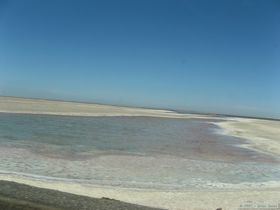 I took off at break-neck speed, trying to glide over the washboards. It worked, sort of. All in all, the drive back to Vizcaíno seemed better than the drive out to Bahía Tortugas, but I had to be extremely diligent in watching for all the road hazards. Occasionally I hit a hidden dip or hump at high speed, which sent me skittering one way or another across the road. Even heavily loaded though, I was impressed with how my truck deals with dirt roads at high speed. Oddly, my truck handled better on the dirt roads at high speed than it did on paved roads at the same speed. My only theory to explain it is that the dirt roads kept my suspension more active, which mitigated the effect of the swaying action.
I took off at break-neck speed, trying to glide over the washboards. It worked, sort of. All in all, the drive back to Vizcaíno seemed better than the drive out to Bahía Tortugas, but I had to be extremely diligent in watching for all the road hazards. Occasionally I hit a hidden dip or hump at high speed, which sent me skittering one way or another across the road. Even heavily loaded though, I was impressed with how my truck deals with dirt roads at high speed. Oddly, my truck handled better on the dirt roads at high speed than it did on paved roads at the same speed. My only theory to explain it is that the dirt roads kept my suspension more active, which mitigated the effect of the swaying action.
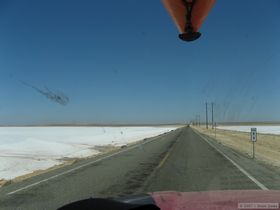 I got to the pavement more quickly than I expected to, but when I talked with Chuck on the radio, he was only 5-10 minutes behind me. I was still airing up my second tire when he pulled up behind me.
I got to the pavement more quickly than I expected to, but when I talked with Chuck on the radio, he was only 5-10 minutes behind me. I was still airing up my second tire when he pulled up behind me.
His CO2 tank works much faster than my air compressor, so he was actually done airing up before me. Then on my last tire, my air hose sprung a leak, so I actually needed to use his CO2 tank to finish my last tire. We hit the pavement together. So much for my plan.
Back at Vizcaíno we got on Highway 1 and started heading north. It was a windy day, so my truck was hard to handle. Instead of getting gas in Vizcaíno, we decided to push on to the larger town of Guerrero Negro, but when we got there, only one gas station had gas. Even worse, only one pump at that one gas station had gas. The line for gas was huge, and we feared that by the time we got to the pump, it too would be out of gas, so we decided to risk heading north in hopes of finding gas at the next, much smaller town of Villa Jesus Maria. Before leaving Guerrero Negro, Chuck put one of his spare cans of gas in his truck. I was pretty certain I could make it to Villa Jesus Maria.
About two-thirds of the way there, my truck sputtered. I radioed ahead to Chuck as I pulled off the road to add my spare gas. If Villa Jesus Maria didn't have gas, we were going to be in a potentially tight spot. It would mean that we would have to take the highway around to Bahía de los Angeles instead of taking the dirt road over the mountain by way of Misión San Borja. Or potentially, it meant we couldn't get much of anywhere.
Fortunately, the Pemex station at Villa Jesus Maria did have gas, so we topped of our tanks and our gas cans and gave a deep sigh of relief. As we neared the turn off to San Borja, we encountered a military checkpoint. When I got out, a piece of trash fell out of my truck. The soldier standing outside my door tried to tell me about it, but I couldn't see it. He was insistent that I pick it up. 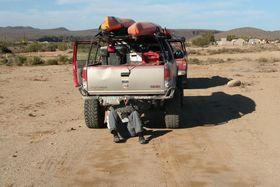 I practically crawled under my truck to see where he was pointing and at the same time that I found the piece of trash, I also noticed something seriously amiss with my truck. My left rear shock was oriented horizontally, trapped between my leaf spring and my spare tire. I figured that I must have broken a shock mount.
I practically crawled under my truck to see where he was pointing and at the same time that I found the piece of trash, I also noticed something seriously amiss with my truck. My left rear shock was oriented horizontally, trapped between my leaf spring and my spare tire. I figured that I must have broken a shock mount.
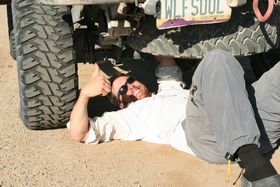 I couldn't deal with it right there at the checkpoint, obviously, so I just assisted the soldiers with their search of my truck and drove away. I radioed ahead to Chuck, who for the first time received less scrutiny than me at a checkpoint, and we decided to wait until the road to San Borja to take a closer look at my broken shock.
I couldn't deal with it right there at the checkpoint, obviously, so I just assisted the soldiers with their search of my truck and drove away. I radioed ahead to Chuck, who for the first time received less scrutiny than me at a checkpoint, and we decided to wait until the road to San Borja to take a closer look at my broken shock.
When we stopped, I was surprised and relieved to discover that what broke was the bar pin on the shock itself. One of the tabs had broken off, allowing the bar to slide out of the bolt holding it in place. It was a potentially easier fix than a broken shock mount. We didn't want to fix it there, so I tied it to the frame with a bungee cord to keep it from getting damaged and we continued on to San Borja.
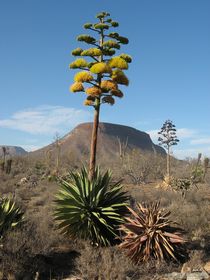 The drive to San Borja was magical. As we approached the mission from the west, with the sun well at our backs, the desert was honey-hued through and through, enhanced further by meters tall agaves in full bloom. The road was of a kind that is extremely fun to drive at a relatively high rate of speed, full of small obstacles and tight, rolling curves.
The drive to San Borja was magical. As we approached the mission from the west, with the sun well at our backs, the desert was honey-hued through and through, enhanced further by meters tall agaves in full bloom. The road was of a kind that is extremely fun to drive at a relatively high rate of speed, full of small obstacles and tight, rolling curves. 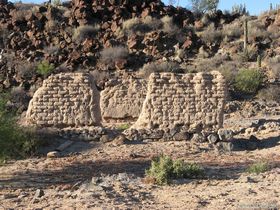 For all this, Chuck was moving quickly. He zipped ahead of me, as I was so lost in place and time that I couldn't force myself into a pace much greater than something geologic in scale. I osmosed the place into my cells. Yet still, I know I realized so little of the space in which I traveled that I could scarcely say I'd ever even been there at all.
For all this, Chuck was moving quickly. He zipped ahead of me, as I was so lost in place and time that I couldn't force myself into a pace much greater than something geologic in scale. I osmosed the place into my cells. Yet still, I know I realized so little of the space in which I traveled that I could scarcely say I'd ever even been there at all.
Occasionally, Chuck and Marisa would stop to collect some firewood or take a picture. That was all that prevented me from falling too far behind, not that I would have particularly cared anyway. Even after a couple of long, hard days of driving that had brutalized my truck, I was riding high. Though I had high hopes for what lay ahead at the mission, I didn't dare go so far as to hope that would compare to the drive getting to it.
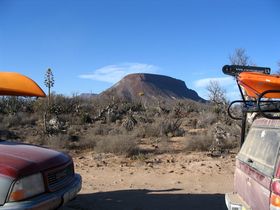
|
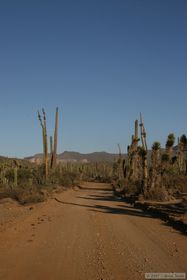
|
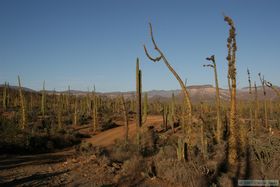
|
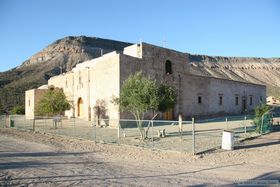 To have dared so would have been completely within reason though. We arrived at the mission perhaps 30 minutes before the sun touched the horizon to find that we were the only travelers there.
To have dared so would have been completely within reason though. We arrived at the mission perhaps 30 minutes before the sun touched the horizon to find that we were the only travelers there. 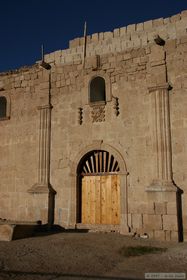 Having the place to ourselves was an unexpected bonus. The family that takes care of the mission has lived there for six generations and we were first greeted by a woman who I assume was the matriarch. She didn't speak English very well, but we gathered that her son did, and could give us a tour of the mission the next day. We paid her for camping at one of the palapas for the night and parked next too the one we wanted.
Having the place to ourselves was an unexpected bonus. The family that takes care of the mission has lived there for six generations and we were first greeted by a woman who I assume was the matriarch. She didn't speak English very well, but we gathered that her son did, and could give us a tour of the mission the next day. We paid her for camping at one of the palapas for the night and parked next too the one we wanted.
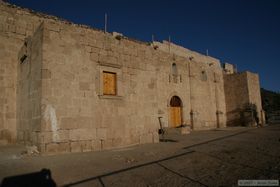 Normally, my first order of business would have been setting up camp, but the evening light and the mission called out to the photographer in me.
Normally, my first order of business would have been setting up camp, but the evening light and the mission called out to the photographer in me. 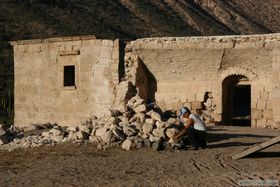 Chuck had the same idea, and we both wandered over to the mission, with Marisa joining us after a short while. The doors of the mission were shut, so we just walked around the outside. There was a young man there working on a large stack of stone with a hammer and chisel, making stones for the mission restoration the old fashioned way. As we wandered around, the young man, Angel, came up and asked if we wanted to go inside the mission. Of course we agreed. Little did we know then, that we were going to get a complete tour.
Chuck had the same idea, and we both wandered over to the mission, with Marisa joining us after a short while. The doors of the mission were shut, so we just walked around the outside. There was a young man there working on a large stack of stone with a hammer and chisel, making stones for the mission restoration the old fashioned way. As we wandered around, the young man, Angel, came up and asked if we wanted to go inside the mission. Of course we agreed. Little did we know then, that we were going to get a complete tour.
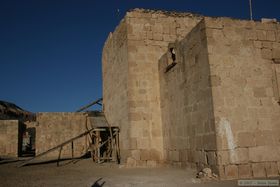
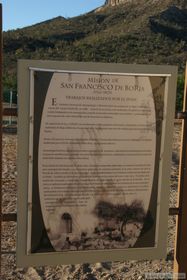
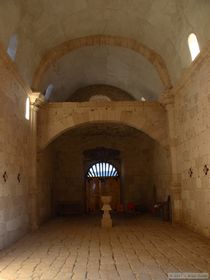 Angel is 18 years old, and spoke English quite well, especially for someone with no formal education in English. He had picked the language up from talking with tourists. Angel is a sixth generation resident of the mission, I gathered with roots even further back to the Indians who inhabited the area before the mission. The area must be very conducive to sticking around, because one of his grandfathers, it is estimated, is about 115 years old!
Angel is 18 years old, and spoke English quite well, especially for someone with no formal education in English. He had picked the language up from talking with tourists. Angel is a sixth generation resident of the mission, I gathered with roots even further back to the Indians who inhabited the area before the mission. The area must be very conducive to sticking around, because one of his grandfathers, it is estimated, is about 115 years old!
Angel did an excellent job of telling the history of the mission. Unfortunately, I have done a less than stellar job of remembering that history. However, there were several phases of development at the site since the arrival of westerners.
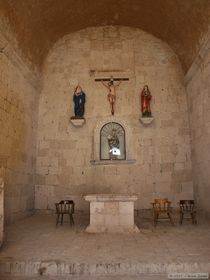
|
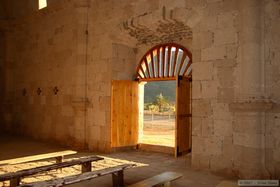
|
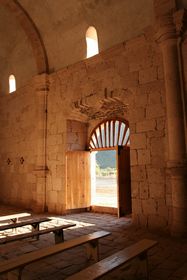
|
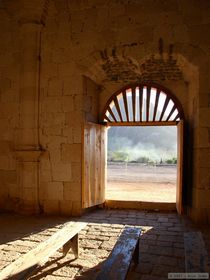
|
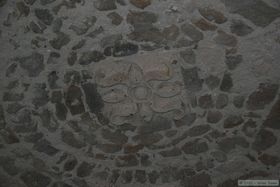
|
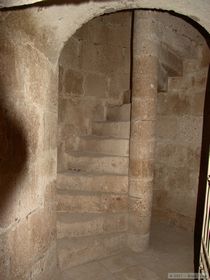
|
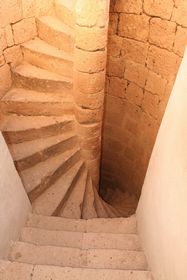
|
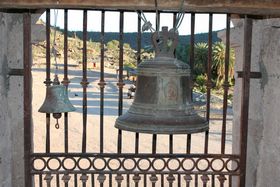
|
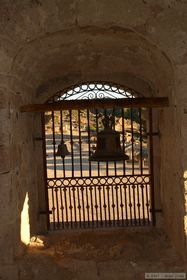
|
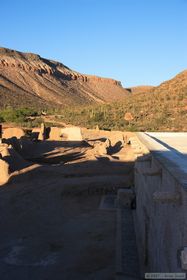 There are two missions at the site, the earliest built by either the Jesuits or the Franciscans who followed them. The first site is in a state of serious decay, with the walls appearing as melted wax.
There are two missions at the site, the earliest built by either the Jesuits or the Franciscans who followed them. The first site is in a state of serious decay, with the walls appearing as melted wax. 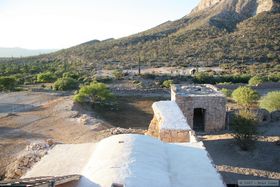 The Franciscans were followed by the Dominicans. Angel very clearly loathed the Dominicans, who treated the Indians very poorly. I don't know if Angel is Catholic, but feel fairly safe in assuming he is, so his detestation of the Dominicans took me aback.
The Franciscans were followed by the Dominicans. Angel very clearly loathed the Dominicans, who treated the Indians very poorly. I don't know if Angel is Catholic, but feel fairly safe in assuming he is, so his detestation of the Dominicans took me aback.
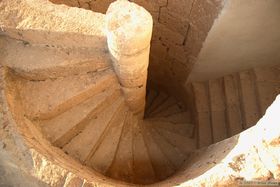 It is, however, rather understandable. When we wound up the tight spiral stone staircase to the roof, he pointed out the cemetery and explained that over 3000 Indians are buried in a mass grave there, marked by a single white cross. He said that when they recently buried one of his grandfathers in the cemetery, they had to dig through hundreds of bones from the Indians in the mass grave.
It is, however, rather understandable. When we wound up the tight spiral stone staircase to the roof, he pointed out the cemetery and explained that over 3000 Indians are buried in a mass grave there, marked by a single white cross. He said that when they recently buried one of his grandfathers in the cemetery, they had to dig through hundreds of bones from the Indians in the mass grave.
The Dominican mission was completed in 1801, made of locally quarried stone. Like most missions in Baja appeared to be, it was both simple and grand. Misión San Borja was a place of two minds, exuding extreme warmth one moment, and chilling the senses an instant later. In either case, it was a place of wonder.
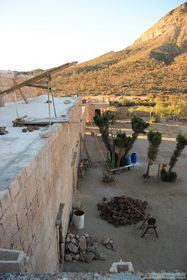 As we wandered around the roof, marveling not only at the mission, but at the wonderful views the roof afforded of the valley in which it stood, Angel pointed out the ongoing restoration work that he and his family were doing along the way, none of it apparently using modern machinery.
As we wandered around the roof, marveling not only at the mission, but at the wonderful views the roof afforded of the valley in which it stood, Angel pointed out the ongoing restoration work that he and his family were doing along the way, none of it apparently using modern machinery. 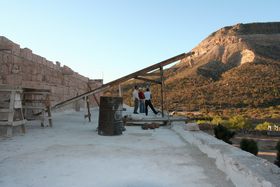 He took us through the auxiliary rooms of the mission as well, the catacombs, the dining area, the residential area, etc. It didn't appear that the catacombs, which were on the same level as the rest of the mission and therefore don't meet the strict definition of the word, had ever actually been used. Most of the auxiliary rooms were poorly lit, making me wish I'd brought my flash.
He took us through the auxiliary rooms of the mission as well, the catacombs, the dining area, the residential area, etc. It didn't appear that the catacombs, which were on the same level as the rest of the mission and therefore don't meet the strict definition of the word, had ever actually been used. Most of the auxiliary rooms were poorly lit, making me wish I'd brought my flash.
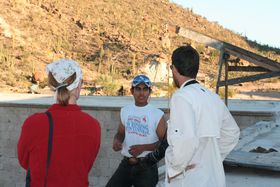
|
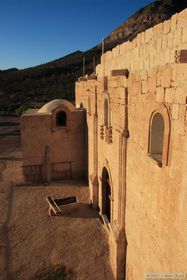
|
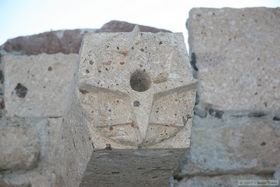
|
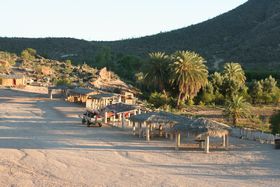
|
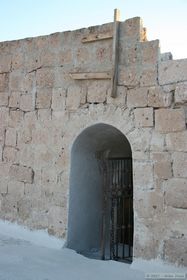
|
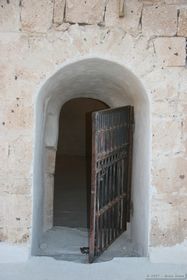
|
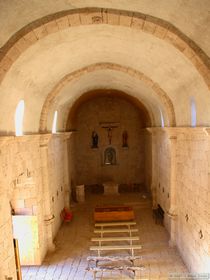
|
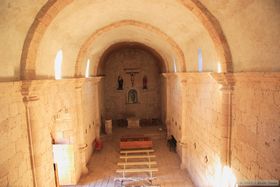
|
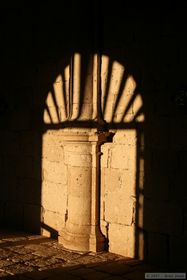
|
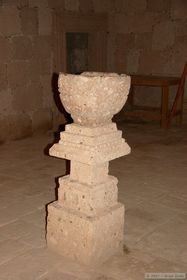
|
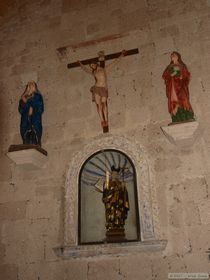
|
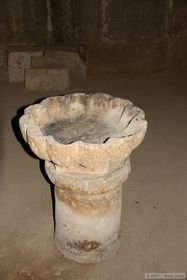
|
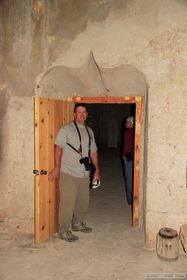
|
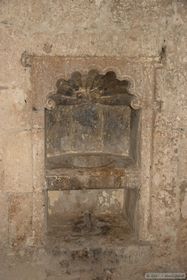
|
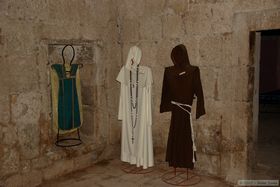
|
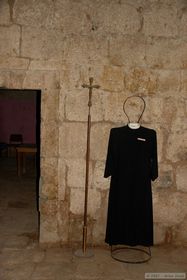
|
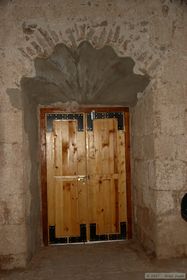
|
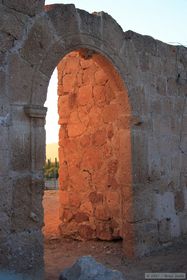
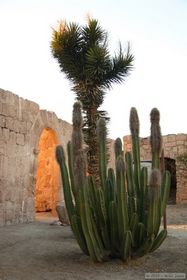
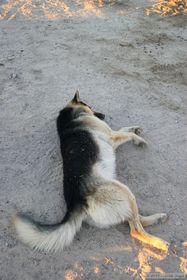 Back outside, we wandered over to the courtyard between the old and new missions and continued talking, not only about the missions themselves, but about living at the mission and other similar subjects. That's where we also met his dog, whose name I think was Bobby, oddly enough. Bobby was an attention hound when Angel was around, and a noisy protector when not.
Back outside, we wandered over to the courtyard between the old and new missions and continued talking, not only about the missions themselves, but about living at the mission and other similar subjects. That's where we also met his dog, whose name I think was Bobby, oddly enough. Bobby was an attention hound when Angel was around, and a noisy protector when not.
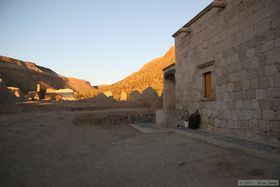
|
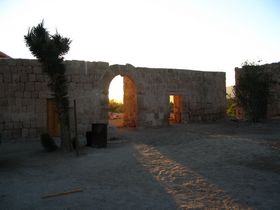
|
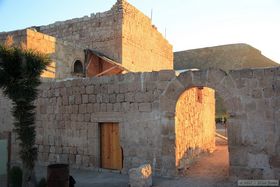
|
Eventually we headed back to our palapa, with Angel chatting with us along the way. 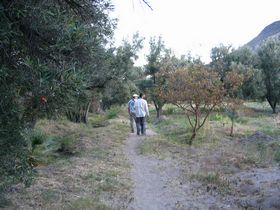 He then took us up the path to the hot springs so we would know how to find it later if we decided to go check it out.
He then took us up the path to the hot springs so we would know how to find it later if we decided to go check it out. 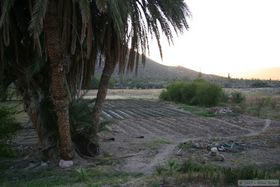 The trail took us past the fields where Angel's family grows their food. They continue to harvest grapes from vines that were planted by the missionaries hundreds of years ago, and until recently Angel's grandfather still made wine from them.
The trail took us past the fields where Angel's family grows their food. They continue to harvest grapes from vines that were planted by the missionaries hundreds of years ago, and until recently Angel's grandfather still made wine from them.
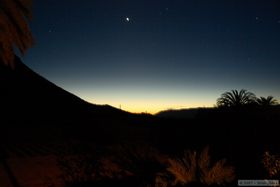 Angel asked what we were going to do that evening, and when we told him we'd probably sit by the campfire a while, he asked if he could join us. We happily agreed. Upon returning to camp, we set about the business of unloading our gear and getting dinner prepared. As we started this, Angel's brother Gilberto joined us as well. They both hung out and watched us as we unpacked our gear and got stuff ready. It was a little unusual to have them just watch, and frankly, it made me very slightly uncomfortable. I think part of that feeling was that I sensed a certain amount of tension between Angel and Gilberto. Gilberto was the older of the two, and I sensed a power struggle over who should help us. I was relieved when, as we got closer to having dinner, first Gilberto then Angel left to have their dinner.
Angel asked what we were going to do that evening, and when we told him we'd probably sit by the campfire a while, he asked if he could join us. We happily agreed. Upon returning to camp, we set about the business of unloading our gear and getting dinner prepared. As we started this, Angel's brother Gilberto joined us as well. They both hung out and watched us as we unpacked our gear and got stuff ready. It was a little unusual to have them just watch, and frankly, it made me very slightly uncomfortable. I think part of that feeling was that I sensed a certain amount of tension between Angel and Gilberto. Gilberto was the older of the two, and I sensed a power struggle over who should help us. I was relieved when, as we got closer to having dinner, first Gilberto then Angel left to have their dinner.
As we were finishing dinner, Angel returned and we all sat around the fire talking. He practiced his English and we practiced our Spanish. For the first time in a while, there was virtually no wind to speak of, and we spent a very pleasant evening talking around the fire.
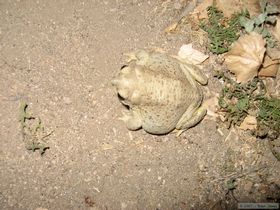 Sometime late in the evening, Angel left and we all started preparing for bed. I had been wanting to go to the hot springs, but didn't want to go by myself so when Chuck and Marisa talked about going I gladly agreed.
Sometime late in the evening, Angel left and we all started preparing for bed. I had been wanting to go to the hot springs, but didn't want to go by myself so when Chuck and Marisa talked about going I gladly agreed.
We wandered down to the hot spring, changed into our swimming gear at the little changing rooms they have set up and got in. The spring is luke warm at best, but it still felt good. Though rock walled, the bottom of the hot spring is a little mucky, so we couldn't move much without stirring up a lot of sediment. We chatted for a good long while about this and that (favorite books, movies, teasing Marisa about falling a swoon for Angel, her Latin lover, etc.) before getting out into the chilly night air and heading back to camp.
I think we all slept well.
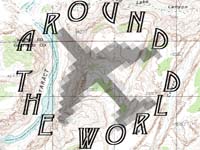 |
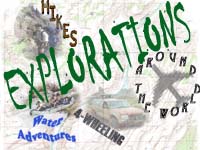 |